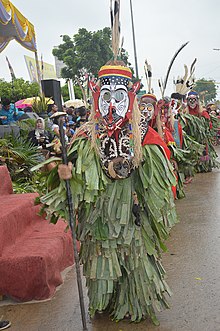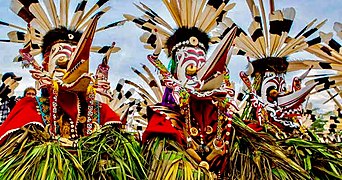Hudoq
This articleneeds additional citations forverification.(September 2007) |
 | |
| Native name | Tari Hudoq |
|---|---|
| Origin | Indonesia(East Kalimantan)[1] |
| Hudoq |
|---|
|
| Burma |
| Cambodia |
| Indonesia |
|
| Laos |
| Malaysia |
| Philippines |
| Thailand |
|
| Vietnam |
Hudoqis a masked dance performed during theErauharvest thanksgiving festival by many of the sub-groups of theDayakethnic group inEast Kalimantan province,Indonesia.[1] TheHudoqculture and performance are indigenous to the Dayak population of East Kalimantan province, and they are said to have originated fromMahakam Ulu Regency.[2]
Mythology[edit]

According to the traditional beliefs of theBahau,Busang,Modang,Ao’heng,andPenihingpeople,hudoqs are thirteen crop-destroying pests, includingrats,boars,leopards,andcrows.In the festival, theHudoqs are symbolized by dancers who wear masks representing pests and jackets made ofpinang(areca palm) orbanana treebark. The entire body is covered with frayed pinang palm leaves. The dance is finished when two human hudoqs come out and chase the pest hudoqs. The duration of the dance is 1–5 hours.
It is arranged from village to village after peopledibblethe land to grow dry-fieldrice paddiesin September to October every year. They pray so that their fields will grow abundantly.[3]
Gallery[edit]
See also[edit]
References[edit]
- ^abBhwana, Petir Garda (2019-10-27)."Government to Patent Hudoq Cross Border Traditional Dance".Tempo.Retrieved2020-10-09.
- ^antaranews.com (26 October 2019)."Government to patent Hudoq Cross Border traditional dance".Antara News.Retrieved2020-10-09.
- ^Maunati, Yekti (2003).Identitas Dayak.Yogyakarta: Lkis Pelangi Aksara.ISBN9789799492982.
Further reading[edit]
- Festival Hudoq di Hulu Sungai Mahakam. Potensi Wisata yang Tidak Tergarap.KOMPAS,Saturday, December 8, 2001. Retrieved on August 28, 2007.













